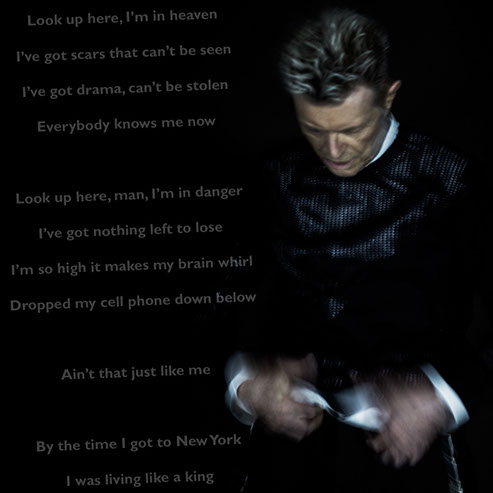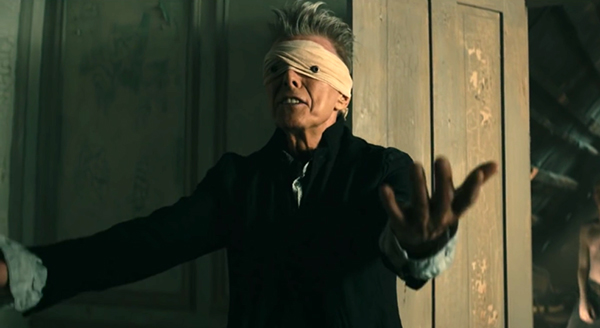
COPYRIGHTS AND RESTRICTIONS AND CONDITIONS OF THIS WEBSITE
DAVID BOWIE • BLACKSTAR and LAZARUS
© 2016 Ron Barbagallo
BLACKSTAR
Last Sunday night, I was robbed from the opportunity of sitting down on Monday morning and drafting a review for David Bowie's new CD Blackstar. My review of what 'that CD' sounded like is lost forever because I barely sat with 'that CD' long enough before learning of that David Bowie died. I'll be honest with you, it was difficult for me to go anywhere near playing the CD until many days afterwards. By midweek, I forced myself to tackle three of the newer songs starting with the title track Blackstar, the ten minute opus which starts the CD. Before learning of his death, I found the song to be obviously "important," harsh, luxuriously crafted but not gaudy. I was lost in understanding fully what it was about.
But context is everything, right?
So what is the song Blackstar about?
Blackstar, the song itself rests as an overture, much like his 70s song Station to Station did. Both song titles are also the title of their respective CDs. Both songs are very long. Both songs seem peculiar and off-putting when you first play them. Both songs complex in their verses. Both songs build.
The difference is Blackstar is a Mass, and a Requiem in the most traditional sort of way and I mean that musically. It is not unlike a Requiem Mozart might have been commissioned to create for some great monarch, and like any great Requiem drafted by a great composer, Blackstar endeavors to be all things: to sum up one's life and to make a statement as one exits.
To do this, Bowie crafted ancient-sounding chants. He sets his Mass in a mythical villa named Ormen (meaning the home of "all men?"). He is quick to discuss "the day of execution" and to set the execution "at the center of it all" - around its people. The masses. His fans. "His children."
The music is saucy, smoky, and if this came out of a 29 year old, it would be considered a splendid alternative rock masterpiece. But it was been drafted by a 69 year old at the top of his game. Musically and vocally, it's remarkable.
At approximately the four minute mark, once Bowie has set the stage for his Mass, you'll see the music pauses. Its mist clears. The air becomes thin and Bowie delivers a Eulogy.
With paternal care, he more or less says "Son, come here. I have something we need to talk about. It's important, and I'm sorry. There is little I can do. I'm dying."
With a calm temperance he phrases it like this:
Something happened on the day he died
Spirit rose a metre and stepped aside
Somebody else took his place, and bravely cried
(I’m a blackstar, I’m a blackstar)
How many times does an angel fall?
How many people lie instead of talking tall?
He trod on sacred ground, he cried loud into the crowd
(I’m a blackstar, I’m a blackstar, I’m not a gangstar)
I can’t answer why (I’m a blackstar)
Just go with me (I’m not a filmstar)
I’m-a take you home (I’m a blackstar)
Take your passport and shoes (I’m not a popstar)
And your sedatives, boo (I’m a blackstar)
You’re a flash in the pan (I’m not a marvel star)
I’m the Great I Am (I’m a blackstar)
In three verses, he sets the stage for his spirit to rise, and asks his fans that if I've taught you anything - it's your turn. The Circle of Life. I've done what I can. Now it's your turn to be a Blackstar.
He even couches his exit in poetic tones. He states death is hardly an original act, but that - thinking with great care - is. So instead of being a gaudy film star, some Internet fool pop star, some rap gangsta', some franchised "Marvel" star, please take the passport I gave you and the shoes you wear in my stead and - BE A BLACKSTAR.
When you consider the violently self-involved world we live in, over-saturated with victim's groups inventing reasons to hate one another and using that 'activity' as an accomplishment, you have to be left in awe at the level of forethought and craft here. I'm unclear I've ever seen an exit much like this one, and I think I will be processing the unexpected size of it for a very long time.
David Bowie in the music video for Blackstar, directed by Johan Renck
LAZARUS
Measured beats of guitar lead one into David Bowie's new song Lazarus, the 'evil twin' to his opus Blackstar and the second single released from his new seven track farewell CD.
If David Bowie wrote the song Blackstar as a requiem to announce his death, and a way for him to ease his fans into acceptance - Lazarus is a song David Bowie simply wrote for himself.
A simpler song than Blackstar in almost every way, Lazarus, is a more heartfelt track. It's sung first person and its lyrics are less cloaked in ceremony or mystery. Its dialog is rather straightforward. So straightforward it's hard to believe no one saw his fear of death coming.
I think the thing that will haunt most hardcore Bowie fans about both songs is how gallingly autobiographical each of them are... down to the line in Lazarus where Bowie sings "Ain't that just like me?!!"
Openly reflective of what it feels like to arrive upon death's door, Bowie's Lazarus also takes time to lament what it feels like to run out of time artistically. Although I'd argue the vocals and the track's arrangements don't reflect that. Bowie has made albums that suffer from being rushed (Aladdin Sane and Tonight) and the tracks Blackstar and Lazarus are not that. They are in a way as manicured as anything he's ever done and as important as his more epic work of the 1970s.
It should be said however, that they are standalone tracks on an album otherwise connected by jazz and blues elements. Feeling somewhat like Young Americans and Station to Station meets Outside the other songs on the Blackstar album sound rather typical of the sort of music Bowie music has been releasing since his 1999 album Hours. And I will get to those other five tracks later on. It was hard enough to absorb and write the Blackstar review I did last Saturday and this one today.
Photograph of David Bowie by Jimmy King



This review is owned by © Ron Barbagallo.
ALL RIGHTS RESERVED. You may not quote or copy from this article without written permission.
YOUR USE OF THIS WEBSITE IMPLIES YOU HAVE READ AND AGREE TO THE "COPYRIGHT AND RESTRICTIONS/TERMS AND CONDITIONS" OF THIS WEBSITE DETAILED IN THE LINK BELOW:
LEGAL COPYRIGHTS AND RESTRICTIONS / TERMS AND CONDITIONS OF USE
INSTRUCTIONS ON HOW TO QUOTE FROM THE WRITING ON THIS WEBSITE CAN BE FOUND AT THIS LINK.
PLEASE DO NOT COPY THE JPEGS IN ANY FORM OR COPY ANY LINKS TO MY HOST PROVIDER. ANY THEFTS OF ART DETECTED VIA MY HOST PROVIDER WILL BE REPORTED TO THE WALT DISNEY COMPANY, WARNER BROS. OR OTHER LICENSING DEPARTMENTS.
ARTICLES ON AESTHETICS IN ANIMATION
BY RON BARBAGALLO:
The Art of Making Pixar's Ratatouille is revealed by way of an introductory article followed by interviews with production designer Harley Jessup, director of photography/lighting Sharon Calahan and the film's writer/director Brad Bird.
Design with a Purpose, an interview with Ralph Eggleston uses production art from Wall-E to illustrate the production design of Pixar's cautionary tale of a robot on a futuristic Earth.
Shedding Light on the Little Matchgirl traces the path director Roger Allers and the Disney Studio took in adapting the Hans Christian Andersen story to animation.
The Destiny of Dalí's Destino, in 1946, Walt Disney invited Salvador Dalí to create an animated short based upon his surrealist art. This writing illustrates how this short got started and tells the story of the film's aesthetic.
A Blade Of Grass is a tour through the aesthetics of 2D background painting at the Disney Studio from 1928 through 1942.
Lorenzo, director / production designer Mike Gabriel created a visual tour de force in this Academy Award® nominated Disney short. This article chronicles how the short was made and includes an interview with Mike Gabriel.
Tim Burton's Corpse Bride, an interview with Graham G. Maiden's narrates the process involved with taking Tim Burton's concept art and translating Tim's sketches and paintings into fully articulated stop motion puppets.
Wallace & Gromit: The Curse Of The Were-Rabbit, in an interview exclusive to this web site, Nick Park speaks about his influences, on how he uses drawing to tell a story and tells us what it was like to bring Wallace and Gromit to the big screen.
For a complete list of PUBLISHED WORK AND WRITINGS by Ron Barbagallo,
click on the link above and scroll down.
Lyrics to Blackstar and Lazarus © David Bowie; ALL RIGHTS RESERVED.
Blackstar logo designed by Jonathan Barnbrook; ALL RIGHTS RESERVED.
Lazarus image © Jimmy King; ALL RIGHTS RESERVED.
The Ethical Method of Repair
The Attention is in the Details
the Lost and FOUND series
RON BARBAGALLO: